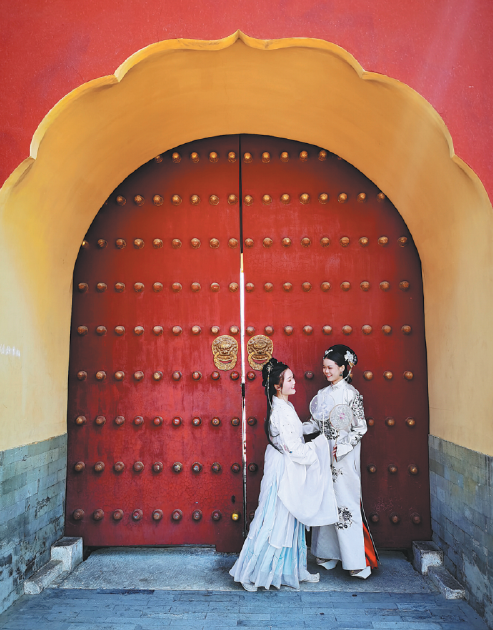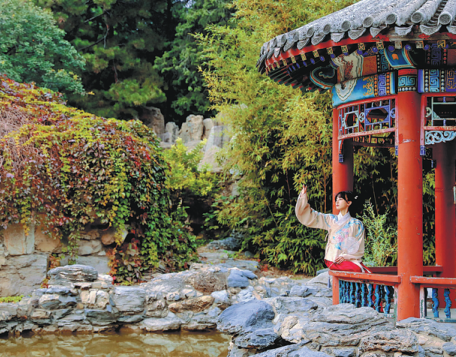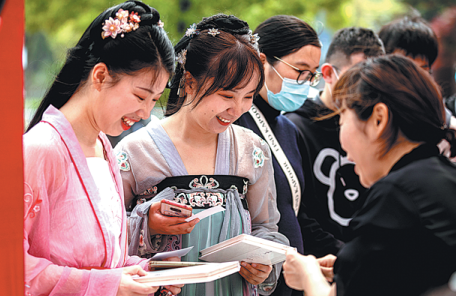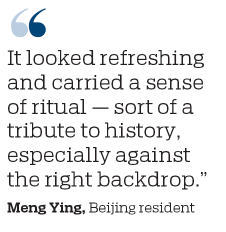A real costume drama
Major scenic spots offer chance to wear stylish hanfu and provide diverse activities to enthusiasts with a sense of style and history, Yang Feiyue reports.
Whenever Meng Ying wears hanfu, she will attract a lot of attention. And she loves it.
"It has never failed to turn heads and some enthusiastic strangers would even come and take pictures with me, especially when I hang out with my friends," says the 24-yearold Beijing resident.
Hanfu generally refers to clothing of the Han people before the Manchus reigned in the Qing Dynasty (1644-1911). The traditional costume often features a long flowing robe with long loose sleeves and a belt at the waist.
Meng tried on hanfu when she visited the Palace Museum about four years ago, after she spotted the trend catching on in scenic sites across the capital.
"It looked refreshing and carried a sense of ritual-sort of a tribute to history, especially against the right backdrop," she says.
As Meng's interests in the historical attire grew, she dived deep into relevant cultural elements and joined a few interest groups.
"It's interesting to see people discussing various aspects about hanfu and some of them even salute each other the old-fashioned way on the streets," Meng says.
According to Guangzhou-based market consultancy iiMedia Research, China's hanfu market has been growing rapidly.
The number of hanfu fans is expected to reach 6.89 million this year, and market sales to hit at least 10.16 billion yuan ($1.58 billion).
A report from business media outlet Yicai and Tmall showed that female consumers born after 1995 made up the biggest consumer group of hanfu in 2019, comprising 80 percent of all consumers.
Popular television dramas and social media influencers have also contributed to the hanfu craze. Many scenic spots have caught up with the hanfu trend and offer related services to tourists.
Forward (Qianzhan) Intelligence, a financial research services provider, says more than 60 percent of people purchase hanfu for fun or for travel, with the remaining 40 percent purchasing hanfu for cultural events or portrait photos.
According to information from travel social-networking platform Mafengwo, the Hengdian World Studios and Xitang town in Zhejiang province, the Palace Museum in Beijing, and Mount Qingcheng in Sichuan province are among the top sites for hanfu travelers.
"Those who like ancient styles have shared many practical tips on taking photos in hanfu on our social platform, including how to capture the lighting and finding a proper backdrop," says Feng Rao, an officer with Mafengwo's tourism research center.
Data from Mafengwo also showed that many tourists have brought their hanfu to these destinations.
Tourists wearing hanfu made their presence felt during the busy Qingming and Labor Day holidays.
At major scenic spots across the country, hanfu parades have emerged and become an attraction. This in turn has contributed to a rise in ticketing revenue. "Many tourists come and rent our hanfu to play," says Lin Yi from China Horse Town resort of Fengning Manchu autonomous county in Hebei province.
Built against the backdrop of vast grasslands, the resort has recreated scenes from the Three Kingdoms period (222-280) to offer an immersive experience for travelers.
They like walking around the resort in their hanfu and watch art performances featuring major historical elements.
"It might help them insert themselves into the scene better and become part of it," Lin explains.
About 30 percent of all visitors have rented hanfu at the resort, with most of them being born in the '80s and '90s.
The popularity of hanfu has had the resort management increase hanfu procurement this year and offer tourists professional photography services.
In the ancient capital Xi'an of Shaanxi province, the superb architecture from the Tang Dynasty (618-907) and profound cultural heritage have also attracted tourists in their hanfu.
Local tour agencies have launched special events to cater to the rising trend.
Hanfu fashion and cultural events featuring hanfu have been organized to offer more fun for historical costume enthusiasts. Local authorities say this is to enhance tourist experience while passing on the charm of traditional culture.
At Nianhuawan in Jiangsu province, more than 3,000 sets of costumes featuring ancient styles were available to travelers for free during its hanfu festival in March.
Featuring Buddhist elements and historical architecture, the scenic spot provides a beautiful backdrop for tourists to try on the ancient costume.
Ancient poetry recitals were also staged for an in-depth historical experience. The event at Nianhuawan drew in a great number of hanfu fans and even encouraged some people to try it on for the first time.
In Beijing's Wtown resort, hanfu can be spotted at many areas of the Simatai section of the Great Wall, along with the surrounding ancient stone buildings and river.
"The costume is especially popular in the fall, with a vast range of red leaves and refreshing weather," says Wang Zuoquan from the Beijing water town management.
Last year, Beijing Wtown's red fall leaves festival attracted more than 50 national cultural and cosplay brands, and generated buzz with more than 110,000 related online topics discussing the festival.
Wang says it is necessary to organize relevant events such as tea and incense ritual observation, as well as fun competitions and ancient cultural learning, so that the craze for hanfu will be sustained.
Meng finds it a great joy wearing hanfu whenever she travels.
"It has added fun to our trips, with all the nice and memorable photos afterward," Meng says.
Some of her friends have grown fond of hanfu with her influence.
"We are not looking for the most popular types of hanfu now, but increasingly for authentic ones in the market-the way the ancients did," she says.
Contact the writer at yangfeiyue@chinadaily.com.cn


















